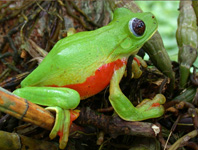Abstract
I clarify the correct provenance and taxonomic identity of the poorly known canopy-dwelling frog, Litoria graminea, from New Guinea. I base my redescription upon analysis of relevant historical material as well as upon more recently obtained specimens from several localities in Papua New Guinea. Determining the correct identity of L. graminea makes clear that one recently named species (L. dux Richards & Oliver) is a junior synonym of that taxon and that additional close relatives of that species remain undescribed, two of which I describe here. The first is known from a series of localities along the southern versant of the Central Dividing Range and the Owen Stanley Mountains. The second is known from a single site in the foothills of the Owen Stanley Mountains in Central Province, Papua New Guinea. Differences among the species are largely confined to pigmentation features and the shape of the male nuptial pads. Further, I show that several morphometric and color-pattern features earlier thought to distinguish among members of this complex are encompassed by natural variation within true L. graminea, making the characters taxonomically uninformative. The two newly described species share the unusual feature of having green oral mucosa, although their bones were white in life. This coloration is presumably due to sequestration of biliverdin, as seen in a few other tropical treefrogs, but the function of this sequestration remains unknown.
References
Allison, A., Bickford, D., Richards, S. & Torr, G. (1998) Herpetofauna. In: Mack, A.L. (Ed.), A biological assessment of the Lakekamu Basin, Papua New Guinea. RAP Working Papers. Vol. 9. Conservation International, Washington, D.C., pp. 58–62 + 156–172.
Austin, C.C. & Jessing, K.W. (1994) Green-blood pigmentation in lizards. Comparative Biochemistry and Physiology, 109A, 619–626.
https://doi.org/10.1016/0300-9629(94)90201-1Barrio, A. (1965) Cloricia fisiologica en batracios anuros. Physis, 25,137–142.
Boulenger, G.A. (1905) Descriptions of new tailless batrachians in the collection of the British Museum. Annals and Magazine of Natural History, Series 7, 16, 180–184.
https://doi.org/10.1080/03745480509443666Dubois, A. & Frétey, T. (2016) A new nomen for a subfamily of frogs (Amphibia, Anura). Dumerilia, 6, 17–23.
Duellman, W.E., Marion, A.B. & Hedges, S.B. (2016) Phylogenetics, classification, and biogeography of the treefrogs (Amphibia: Anura: Arboranae). Zootaxa, 4104 (1), 1–109.
https://doi.org/10.11646/zootaxa.4104.1.1Goin, C.J. & Goin, O.B. (1968) A new green tree frog from Suriname. Copeia, 1968, 581–583.
https://doi.org/10.2307/1442028Greer, A.E. & Raizes, G. (1969) Green blood pigment in lizards. Science, 166, 392–393.
https://doi.org/10.1126/science.166.3903.392Grismer, L.L., Thy, N., Chav, T. & Holden, J. (2007) A new species of Chiromantis Peters 1854 (Anura: Rhacophoridae) from Phnom Samkos in the northwestern Cardamom Mountains, Cambodia. Herpetologica, 63, 392–400.
https://doi.org/10.1655/0018-0831(2007)63[392:ansocp]2.0.co;2Günther, R. & Richards, S.J. (2000) A new species of the Litoria gracilenta group from Irian Jaya (Anura: Hylidae). Herpetozoa, 13, 27–43.
Hoogmoed, M.S. (1979) Resurrection of Hyla ornatissima Noble (Amphibia, Hylidae) and remarks on related species of green tree frogs from the Guiana area. Notes on the herpetofauna of Surinam VI. Zoologische Verhandelingen, 172, 3–46.
Kraus, F. & Allison, A. (2001) A review of the endemic New Guinea microhylid frog genus Choerophryne. Herpetologica, 57, 214–232.
Kraus, F. & Allison, A. (2004) Two new treefrogs from Normanby Island, Papua New Guinea. Journal of Herpetology, 38, 197–207.
https://doi.org/10.1670/100-03AMenzies, J.I. & Zug, G.R. (1979) Papuan tree frogs of the Litoria thesaurensis group (Salientia: Hylidae). Micronesica, 15, 325–333.
Parker, H.W. (1936) A collection of reptiles and amphibians from the mountains of British New Guinea. Annals and Magazine of Natural History, Series 10, 17, 66–93.
https://doi.org/10.1080/03745481.1936.10801389Richards, S.J. & Oliver, P.M. (2006) Two new species of large green canopy-dwelling frogs (Anura: Hylidae: Litoria) from Papua New Guinea. Zootaxa, 1295, 41–60.
Richards, S.J., Oliver, P.M., Dahl, C. & Tjaturadi, B. (2006) A new species of large green treefrog (Anura: Hylidae: Litoria) from northern New Guinea. Zootaxa, 1208, 57–68.
Rodriguez, Z.B., Perkins, S.L. & Austin, C.C. (2018) Multiple origins of green blood in New Guinea lizards. Science Advances, 4, eaao5017.
https://doi.org/10.1126/sciadv.aao5017Rossauer, D., Laffan, S.W., Crisp, M.D., Donnellan, S.C. & Cook, L.G. (2009) Phylogenetic endemism: a new approach for identifying geographical concentrations of evolutionary history. Molecular Ecology, 18, 4061–4072.
https://doi.org/10.1111/j.1365-294X.2009.04311.xSharpe, R.B. (1906) Birds. In: The history of the collections contained in the natural history departments of the British Museum. Vol. II. separate historical accounts of the several collections included in the Department of Zoology. William Clowes and Sons, Ltd., London, pp. 79–515.
Tennent, W.J. (2010) The “long-winged Troides”: discovery of the largest butterfly in the world, in Papua New Guinea, by Albert Stewart Meek (1871–1943). The Linnean, 26, 28–38.
Tyler, M.J. (1968) Papuan hylid frogs of the genus Hyla. Zoologische Verhandelingen, 96, 1–203.
Tyler, M.J. (1971) The phylogenetic significance of vocal sac structure in hylid frogs. University of Kansas Publications, Museum of Natural History, 19, 319–360.
https://doi.org/10.5962/bhl.part.15451Tyler, M.J. (1976) Frogs. Collins, Sydney, 256 pp.
Wiens, J.J., Kuczynski, C.A., Hua, X. & Moen, D.S. (2010) An expanded phylogeny of treefrogs (Hylidae) based on nuclear and mitochondrial sequence data. Molecular Phylogenetics and Evolution, 55, 871–882.
https://doi.org/10.1016/j.ympev.2010.03.013

